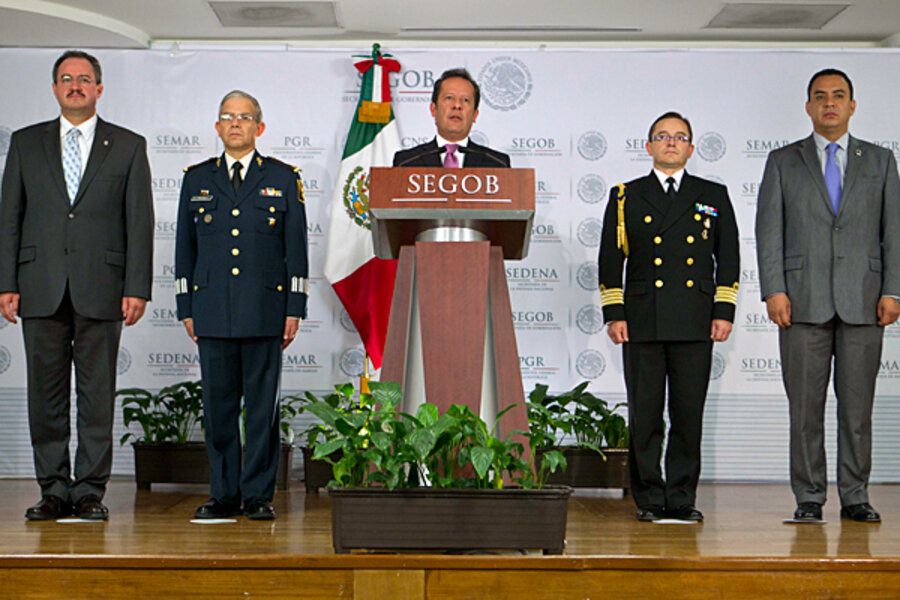Capture of Zetas leader may bring more violence
Loading...
• A daily summary of global reports on security issues.
On Monday, Mexican authorities captured Miguel Angel Treviño Morales, leader of the Zetas drug cartel, striking a major blow against the country's most notorious cartel. But experts say that the surprisingly bloodless capture of the man known as Z-40 will likely open the door to new violence in Mexico, as the cartel's factions and rivals fight for control of Zetas turf.
The Dallas Morning News reports that Mr. Treviño Morales was captured near Nuevo Laredo around 3:45 a.m. on Monday morning after being pursued by Mexican authorities. No shots were fired during the pursuit, which ended with Treviño Morales, his bodyguard, and his treasurer in custody. Eduardo Sanchez Hernandez, spokesman for Mexico’s interior secretary, said that authorities found $2 million, nine weapons, and 500 rounds of ammunition in their vehicle.
The Morning News adds that according to authorities, Treviño Morales had been visiting his newborn child in Nuevo Laredo.
Former FBI agent Arturo Fontes told the Morning News that he was surprised that Treviño Morales had been captured alive. “He had told his closest associates he’d rather be captured dead than alive,” he said. But Mr. Fontes added that “This is a huge hit for the new government.”
“History will show that Chapo Guzman [Joaquin “Chapo” Guzman, leader of the Sinaloa cartel] was the bigger narco, but ‘40’ was the villain, the enforcer and game changer, the one who changed the landscape for Mexico, introducing unimaginable violence to the country,” he said.
The Associated Press reports that Treviño Morales "is uniformly described as one of the two most powerful cartel heads in Mexico, the leader of a corps of special forces defectors who went to work for drug traffickers, splintered off into their own cartel in 2010 and metastasized across Mexico, expanding from drug dealing into extortion, kidnapping and human trafficking."
On Trevino Morales' watch, 72 Central and South American migrants were slaughtered by the Zetas in the northern town of San Fernando in 2010, authorities said. By the following year, federal officials announced finding 193 bodies buried in San Fernando, most belonging to migrants kidnapped off buses and killed by the Zetas for various reasons, including their refusal to work as drug mules.
Trevino Morales is charged with ordering the kidnapping and killing of the 265 migrants, [government spokesman] Sanchez said.
But while his capture "is the most important since Enrique Peña Nieto became president in December 2012," writes InSight Crime, a news organization focused on Latin American crime, it "may have the opposite effect than what most expect."
While Treviño was known for his brutal beheadings and gruesome executions of those who were "not aligned" with the Zetas, and he had consolidated his hold on the organization in recent months, his capture may open the door for a full-scale battle for his territories by both the Zetas and their rivals. ...
Although Treviño's brother, Omar, alias Z-42, is the presumed number one, it is not clear that he has the gravitas or the ability to hold this disparate and volatile organization together.
The Zetas have experienced some fracturing in recent years, particularly in October 2012 with the death of the group's top man and Treviño Morales' primary rival, Heriberto Lazcano. Treviño Morales had been able to hold the organization together, InSight writes, "but his capture will reopen the possibilities for his internal rivals to go after the top spot."
Further, Treviño Morales' capture raises the threat of new turf wars between the Zetas and their main competitors, the Sinaloa Cartel and the Gulf Cartel. The Zetas started their existence as the paramilitary enforcers of the Gulf Cartel before breaking away and becoming an independent criminal organization, and have fought several major battles with their rival cartels.
InSight notes that in particular, Nuevo Laredo, "the Zetas' most coveted prize" and a major conduit in the Mexico-US drug trade, "has been in dispute of late" -- and could see more violence if the Sinaloa and the Gulf Cartels now regard the city as up for grabs.
[Nuevo Laredo] saw its highest number homicides on record last year at 288, making it the eighth most violent city in the world, according to a Mexican watchdog group.
The carnage may have been worse than reported: sources close the mayor's office told InSight Crime that authorities had recovered close to 550 bodies during what was an all out war between the Zetas and their rivals in the Sinaloa and Gulf Cartels, which included rocket-propelled grenades and regular gunfights on the city's streets.









